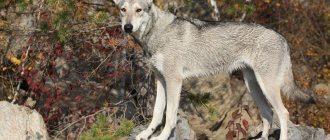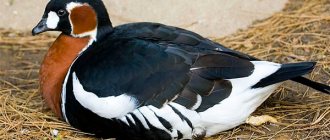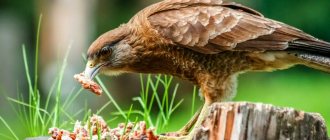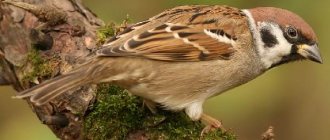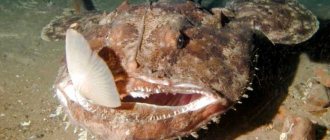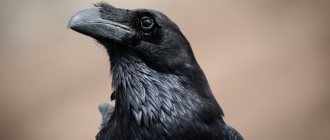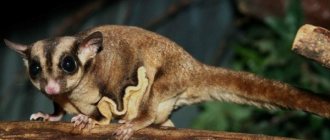| Latin name | Branta bernicla |
| English name | Brant goose |
| Squad | Anseriformes |
| Family | Duck |
| Body length, cm | 55-62 |
| Wingspan, cm | 105-117 |
| Body weight, kg | 0,8-1,2 |
| Features | The head, neck and chest are black; there is a whitish crescent on the neck; it is found only in adult birds. |
| Number | About 40,000 |
| Security status | Least Concern |
| Habitats | Breeds in the Arctic on swamps, islands and tundras. In winter, it lives in lagoons, river mouths, salt marshes near sandbars, barrier beaches and ocean shores. |
| Additionally | The brant goose is divided into three subspecies: the brant goose, Branta bernicla bernicla (Linnaeus, 1758), the pale-bellied goose, Branta bernicla hrota (Müller, 1776), and the American goose, Branta bernicla nigricans (Lawrence, 1846). |
- 2.1 Range
Description
The brent goose is a gregarious bird of the Anatidae family that forages for food by wandering in shallow water or along the coastline. During periods of migration, birds can fly up to several thousand km.
Number
— Advertising —
In the 1960s, the population fluctuated from 10,000 individuals and grew to 40,000 by 2010.
Structure and dimensions
The brant goose is a relatively small species that has a dark brown upper body as well as brown stripes along it. The lower part is pale gray. The head of the goose is black, the neck is short and black, and the beak is small. There is a white crescent-shaped spot on the neck. The species has the shortest tail of all types of geese. The lower part of the tail is white and the upper part is black. The birds also have black beaks and legs; the young ones have a red beak tip.
The dimensions of the species are as follows: average body length 55–62 cm, wingspan about 105–117 cm, weight approximately 860–1250 g.
Lifestyle
The red-breasted goose is a very tireless and active bird; in addition, it loves to communicate and adapts to new conditions quite easily. In flight, it is more like a red duck than a goose, with which it is constantly compared. During the non-moving period, birds are usually distinguished by their characteristics such as restlessness and constant movement from one point to another. If they were like geese, they would be more motionless and calm.
It has already been said that the goose is a waterfowl, so it has good ability to dive to depth. Descending into the depths, you can hear the various sounds it makes: a barely audible hoarse cackle, as well as a scream. Thus, representatives of this family communicate with each other and transmit information about whether it is safe there. In addition, sometimes you can hear sounds similar to a snake hissing.
For nesting houses, geese usually use bushes, as well as lichens on the tundra. In addition, when choosing a place, they use various criteria; it is desirable that the place is located on a hill, not far from the water, close to the weeds. They often hatch eggs on the coastal areas of rivers with sharp turns, and very rarely nest on rocks.
Habitat
— Advertising —
Breeds in the Arctic on swamps, islands and tundra. In winter, it lives in lagoons, river mouths, salt marshes near sandbars, barrier beaches and ocean shores.
Area
Breeds on the Arctic coasts of central and western Siberia. Winters in western Europe: more than half of the population is in the south of England, the rest is between northern Germany and northern France.
Food
Basically, geese eat grass, horsetails, roots, and various greens. During the flight, their diet consists of dried plants from the steppe and semi-desert, various cereals and grain crops, such as barley and millet. Birds have to feed in the same place where they spend the night. They feed on the food that they obtained during the day, and under good circumstances they can find a watering hole.
During drought, red-breasted geese have to switch to food that they get in semi-deserts and even deserts.
Nutrition
The main diet of the species consists of plant products. Birds forage in groups along shorelines, in shallow waters, and along tidal flats.
Migratory patterns of a species influence feeding depending on the time of year. During their winter migration to the Arctic, they consume marine food, which consists of green algae, sea lettuce and stone grass.
In their normal environment, geese eat sedge, algae and grass. Birds rarely consume insects, worms and shellfish. In summer, geese can be found in salt marshes and freshwater lakes feeding on moss.
Historically, the bird's diet was predominantly eel. In the 1930s, disease killed off most of these fish throughout the world, which also partly led to a decline in the goose population. The surviving birds adapted to an alternative diet - plant-based.
Now brant geese additionally obtain food on pastures, thanks to which they have been able to diversify their diet.
Several behavioral features
The Canada goose has some features that distinguish it from representatives of other wild breeds:
- Goose chicks are independent and from childhood are adapted to survival because they can quickly walk on the ground and swim.
- Canada geese have a calm character; they show aggression only during the mating season and protecting the nest.
- If several females hatch chicks in one flock, their nests are located at a great distance from each other.
- The diet of geese is dominated by greens, so they live near bodies of water.
- When migrating to wintering grounds, birds can move in one large flock.
Ornithologists say that males and females make different sounds. They can be easily distinguished if you hear the communication of Canadians on the ground. Also, a peculiarity of geese and geese is that they fly much worse than representatives of other waterfowl breeds. That is why it is preferable for them to swim or walk on land.
Reproduction
Brent geese are monogamous and raise their young together.
The breeding season lasts up to 3 months and begins in June when weather conditions are favorable.
When birds arrive at breeding sites, females build nests in shallow depressions in the ground with down, moss and grass. A girl reaches puberty at the age of 2-3 years. The female incubates about 3-5 eggs for 22-25 days. At this time, the male protects the family from potential enemies and other birds.
How do mating games and copulation take place?
Female Canada geese breed in early spring, when warm weather sets in and the flock migrates. Birds always nest in areas where the weather is warm. But mating games begin in mid-spring, when night temperatures in the northern regions are below freezing. The cold does not prevent geese from actively seeking partners for mating.
During mating games, a whole performance takes place on the pond. The Canada goose bends its neck and thereby expresses its readiness to mate. The main role is played by the strongest representative of the pack, who drives away all the other individuals. If the female likes the goose, she also bends her neck and falls to the water, after which mating occurs, which does not last long. The Canadian climbs on the female, bites the back of her head, after which sexual intercourse begins. During the final, the Canadian screams loudly and flaps his wings.
Black goose in the Red Book
The main causes of death for this type of bird are sport and regular hunting, loss of habitat and a decrease in the amount of food. Geese are particularly susceptible to mortality as they return from extreme conditions in the Arctic and are therefore weakened by inadequate nutrition, travel and weather.
Another source of declining populations is the loss of eel fish due to habitat loss and wetland diseases. Birds are vulnerable to chemical pollution that enters estuaries from urban sources and agricultural runoff.
Countries such as Mexico, Canada and the United States have considered actions to mitigate the impact of habitat degradation for the species. Regulations have been put in place in Alaska and Canada to limit hunting and trapping of the species. Measures have also been introduced to prevent pesticides and pollutants from polluting rivers and streams entering watersheds from agricultural and urban sources.
Since the initial protection of brent geese in the 1930s, efforts have been made to conserve eel populations.
During the winter season, some birds live in parks along the coast in British Columbia, Canada. They have a "no dog" policy to reduce pollution and stress on the species.
Where do birds like to nest?
After mating games and copulation, future parents begin to build nests. Most often, females prefer to plant them on the ground near rivers and lakes, so that there is always food nearby. But sometimes, in order to protect the “home” from destruction, females build it in the trees. This measure is necessary in regions where arctic foxes live, which love to eat eggs and chicks.
Canadians also build nests next to polar owls, which protect females while incubating eggs. However, there is an option that the bird will grab the goslings, which will go looking for food for themselves. If the nests are near the owls, the babies will need time to get to the food area. Geese also like to settle on small islands of land in the water so that they do not have to go far in search of food.
Interesting Facts
- The maximum lifespan of a brant goose is up to 27 years, but is usually around 19 years.
- The length of the bird from the tip of the beak to the tip of the tail is 56-61cm.
- The word "brent" comes from the Norwegian word "brend", which means "burnt". Geese were given this name because of their color, which is similar to charcoal.
- A single bird can travel more than 200,000 km in its lifetime between its winter habitat in the UK and its summer habitat in the Arctic tundra.
- This dark little goose is often mistaken for a duck.
- Geese have a highly developed salt gland, which allows them to drink salt water.
- The brant goose is one of the species to which the Treaty on the Conservation of African Migratory Waterbirds applies.
- Asian populations of the species were previously considered a separate subspecies orientalis based on the supposed lighter coloration of the upper parts. However, such assumptions have now been abandoned.
- Unlike the Canadian, the black type does not travel in a V-shaped flying formation. This type flies together in a grouped, disorganized flock.
- The species' northern habitat is expected to expand as global temperatures increase. Scientists expect the brant's winter range in the Pacific Northwest to soon extend into northern Canada and Alaska.
- This is a silent bird: its voice is quiet, similar to a nasal muttering.
Goose: geese that throw their babies from a height of 80 meters
Geese, as you know, are not the most noble representatives of the bird family. From childhood we know that all they can do is want to eat all the time and say their signature “ha-ha-ga.” Well, grab it by the heels if you make the winged colossus very angry.
Source: yandex.ru
We are talking about those familiar white geese that are bred by lovers of natural farming. But you can also find these birds in nature, and believe me, they are no more friendly than their domesticated counterparts. They are called geese and live mainly in the Tundra and Taimyr. For harsh individuals, harsh conditions. True, the birds still fly to the Black Sea region and the Southern Caspian region for the winter.
Kakzarki have predominantly dark colored feathers, only the head remains white. Some species are colored not only in black and gray tones, but have bright spots on the body, such as the red-throated. We are sure you already understood which place they have painted brick-red, even without our explanation.
Yes, that's it, neck and cheeks. What did you think? Source: yandex.ru
These birds grow up to 70 cm in length, and their weight can reach 2 kg. At the same time, birds fly, swim and run well. What life in the Tundra can teach you!
Source: yandex.ru
Winged creatures feed mainly on plant foods, but they do not disdain small insects. They live in flocks of up to 200 animals. This is not done out of great love for fellow humans, but for safety reasons. Geese do not have powerful jaws, impressive size or other frightening attributes. But there are wings and a loud, piercing voice. When danger arises, which, by the way, awaits them at almost every step, the birds simultaneously begin to make noise and flap their wings, creating noise and bustle around them. A confused predator most often prefers to retreat rather than deal with these crazy birds.
Source: yandex.ru
Arriving from warm regions, the first thing geese do is start a family. The male uses all possible means to seek the attention of the chosen lady - and sings, if you can call it that, and dances, and courtes her from all sides. When the female honors the groom with attention, they go together to build a nest. By the way, if these birds create a family, then for life. All available materials, including the female’s feathers, are used to build the nest. It is dangerous for geese to nest on the ground, as they will become easy prey for predators. Therefore, to hatch their offspring, they climb steep cliffs, the height of which can reach 80 meters.
Source: yandex.ru
One litter consists of 3-9 eggs, depending on your luck. And then the most exciting thing happens. Some time after the chicks are born, the parents are faced with the task of teaching them all the delights of life. But how to do this in rocky conditions? No way. Therefore, the kids need to be lowered to the ground. This is not done in the most humane way - parents simply throw the babies out of the nest from the height of a 20-story building. If the cub does not break its neck or crash against the rocks, then it will safely continue to live with its parents. The probability is 50/50.
Source: yandex.ru
A month after birth, the babies are already able to fly, and by 1.5-2 years they can already have offspring themselves.
In captivity, geese live and reproduce poorly, and are practically not tamed, having a harsh disposition. You can admire them at the Moscow Zoo.
For a long time, geese were exterminated en masse by hunters because of the taste of their meat. But today hunting these birds is prohibited and punishable by law.
1111
Appearance
Externally, the barnacle goose differs significantly from other representatives of the duck family. She has a black body, a white mask on her head, and a white apron covering her chest. There is also a brown color on the wings. It also differs in size from other ducks: its body length does not exceed 75 cm, and it weighs no more than 3 kg.
Many see the similarity of the appearance of the barnacle goose with the description of the monastic decoration. The combination of black and white is uncharacteristic of other ducks. Only one species - the Canada goose - has a similar color, which differs in that it seems to be done in reverse: its body is covered with white feathers, and there is a black mask on its head.
Tula bird
A breed with a low egg production rate, and the weight of geese reaches up to 6 kg. But Tula geese are valued for their fighting qualities. Animals are not difficult to breed, because they are able to withstand not only severe frosts, but also extreme heat. They can withstand all conditions, but you need to carefully monitor their nutrition - excess weight can cause a fighter to lose shape.
Shadrinsky geese
It is difficult to call this bird not resistant to frost, but it is important to make floors in the poultry house that will remain warm and dry. The optimal temperature for this breed is 18 degrees. The peculiarity of the bird is that it is not picky about food. When breeding geese, the farmer focuses on obtaining meat, since their weight is about 6 kg. The meat of Shadrinsky geese is very tasty and healthy. Goose down is very hard and is not in great demand.
The liver of the Shadrinsky goose reaches 400 g, which is why the birds are highly valued among breeders.
How many mysterious birds are there?
These anseriformes are listed in the Red Book. This is due to the fact that their natural habitats and migrations were violated. Numerous attacks by predators and the destruction of clutches also influenced this process. A similar situation occurred in the north, where geese spend the winter. Northerners, accustomed to hunting anseriformes, also contributed to the extermination of the species. The birds are caught, fattened, and then slaughtered. Wild bird meat has a specific marine smell; to remove it, brant goose is slaughtered only after being fed with grain.
To date, measures have been taken to preserve the species. The habitats of individuals, as well as migration sites, became nature reserves. There is a long-term ban on hunting geese. There is an article for illegal shooting of anseriformes with all the ensuing consequences. All these measures have undoubtedly contributed to an increase in the number of birds, but compared to the last century, the population is still negligible, so we must not allow this species of anseriformes to become extinct.
Breed lifestyle
A female can have healthy offspring only in favorable conditions. Birds need clean water and lots of greenery. The flocks feed on the remains of wheat and barley after the harvest. The goose nests once a year, mainly in the summer, when there is plenty of green food and water.
Geese groups migrate in the fall before the onset of the first cold weather. Birds move along large rivers, even if this requires covering a large number of kilometers. Young animals of any species travel with adult geese and participate in obtaining food for the flock.
